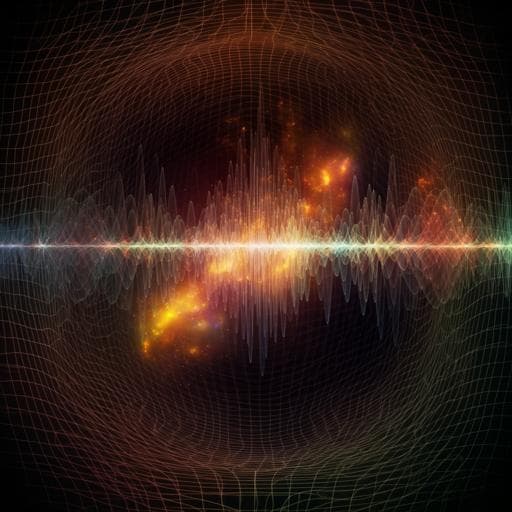
Physics
Observation of Bloch oscillations and Wannier-Stark localization on a superconducting quantum processor
X. Guo, Z. Ge, et al.
This groundbreaking research by Xue-Yi Guo and colleagues explores Bloch oscillations and Wannier-Stark localization using a 5-qubit superconducting processor, unveiling thermal transport phenomena under linear potentials. Their findings open new avenues for simulating complex quantum many-body systems.
~3 min • Beginner • English
Introduction
The paper investigates transport phenomena in a quantum simulator, focusing on Bloch oscillations (BOs) and Wannier-Stark localization (WSL), quantum effects predicted for electrons in periodic lattices under constant force. Direct observation in bulk materials is hindered by short coherence times; earlier experimental observations occurred in semiconductor superlattices, and simulations have been performed with cold atoms and photonic waveguides. Superconducting circuits offer scalability, long coherence times, and high-precision control, making them suitable for simulating BOs and related transport phenomena. The research question is whether a superconducting 5-qubit processor implementing an effective isotropic XY chain with a linear on-site potential can exhibit BOs and WSL for spin transport, and whether associated thermal transport is similarly suppressed. The study’s purpose is to demonstrate BOs/WSL in this platform, quantify localization length versus potential gradient, and measure energy transport using simultaneous multiqubit readout—addressing a gap in prior simulations that lacked energy transport measurements.
Literature Review
The authors review foundational predictions by Bloch, Zener, and Wannier on oscillations and localization in crystals under constant fields. Experimental observations in semiconductor superlattices were achieved in the 1990s, though relaxation times limited studies. Quantum simulation platforms with longer coherence—ultracold atoms and photonic waveguide arrays—have observed BOs and related dynamics. Superconducting circuits have emerged as versatile quantum simulators for many-body dynamics, chemistry, and algorithms, with demonstrations including correlated quantum walks and localization. However, prior simulations generally lacked measurements of energy (thermal) transport that require precise simultaneous multiqubit readout, a capability provided by superconducting qubits.
Methodology
Platform and model: A 5-qubit superconducting transmon processor in a 1D chain with capacitive nearest-neighbor coupling is used. Each qubit’s frequency is individually tunable via flux-bias (Z) lines; qubit rotations are applied via XY lines. Each qubit couples to its own readout resonator enabling simultaneous single-shot readout. The underlying Bose-Hubbard model with negative anharmonicity (on-site attractive interaction) is engineered, with local potentials set via DC biases. Due to large and staggered anharmonicity relative to coupling, each site’s Hilbert space truncates to two levels, reducing the model to an isotropic XY spin-1/2 chain with conserved total excitation number and, for time-independent settings, conserved energy. A linear potential is imposed as ħ_i = F i, where F is the nearest-neighbor detuning (potential gradient). Evolution times t ≤ 300 ns are used, much less than decoherence times (>17 µs), so conservation laws are effectively maintained.
Spin transport experiment: Qubits are initialized in |0⟩ at idle frequencies. The leftmost qubit Q1 is excited with an X gate to prepare |10000⟩. A fast Z pulse biases all qubits to the working point implementing the desired linear potential; the system evolves under the effective XY Hamiltonian for time t. Qubits are then returned to idle frequencies and read out simultaneously. The site-resolved excitation probability P_i(t) = ⟨σ_i^+ σ_i^-⟩ is measured versus time for gradients F/2π = 0, 5, 10, 15 MHz up to 300 ns. Each data point averages 6 × 100 single-shots; errors are obtained by grouping single-shots into 6 sets and using the standard deviation of group means.
Extraction of WSL length: In finite chains, direct exponential tail fitting is complicated by boundaries. The authors define P_max = max_t P_5(t), the maximum occupation observed at the opposite edge (Q5) during the evolution, and show phenomenologically that ξ_WSL ∝ 1/ln P_max. Experimentally, P_5(t) is fit with a Gaussian near the first peak to obtain P_max; ln P_max is then analyzed versus F.
Thermal (energy) transport experiment: To create an initial energy gradient between edges, the state |XX,000⟩ is prepared with X/2 gates on Q1 and Q2 (|X⟩ = (|0⟩+|1⟩)/√2). Time evolution under the same Hamiltonian proceeds as above. The kinetic energy densities at the two edges are defined on bonds and measured via simultaneous two-qubit readout of nearest neighbors. Data points average 10 × 200 single-shots with error estimation by grouping into 10 sets. Energy transport is assessed by comparing time-dependent kinetic energy densities at the two edges for F/2π = 0 and 15 MHz.
Device fabrication and measurement: The 5-qubit Xmon device is fabricated on sapphire with Al thin films, patterned by photolithography and wet etching; Josephson junctions are made by double-angle evaporation with intermediate oxidation. The chip is mounted in an aluminum package at <15 mK in a dilution refrigerator with extensive shielding. XY control is via AWG-shaped IQ-modulated microwaves split into 5 channels; Z control combines DC bias and fast pulses via bias-tees. Readout uses multiplexed tones (40 MHz spacing) with amplification by a Josephson parametric amplifier and HEMT, then room-temperature amplification and demodulation.
Numerical modeling: Dynamics are simulated by solving the Lindblad master equation including energy relaxation and dephasing with experimentally calibrated parameters, to compare with experimental data for both spin and energy transport.
Key Findings
- Spin transport without gradient (F = 0) exhibits light-cone-like propagation and boundary reflections, consistent with the isotropic XY chain dynamics.
- Under a linear potential (F ≠ 0), spin propagation is suppressed; excitations oscillate near their initial positions, demonstrating Bloch oscillations and Wannier-Stark localization. Increasing |F| strengthens localization and reduces reach to the far boundary.
- From experiments at F/2π = 15 MHz, the Bloch oscillation “frequency” (as reported in the paper; effectively the temporal period scale) is about 50 ns, well within coherence constraints (t ≤ 300 ns; T1,T2 > 17 µs).
- A finite-size proxy for localization length using the maximum opposite-edge occupation P_max shows that ln P_max scales approximately linearly with F; thus ξ_WSL ∝ 1/F is verified experimentally. Gaussian fitting of the first peak of P_5(t) yields P_max values; numerical simulations show consistent trends.
- Thermal (energy) transport mirrors spin transport: with F = 0, kinetic energy densities at the two edges exchange freely over time; with F/2π = 15 MHz, an energy gradient persists without crossing of edge energy curves, indicating suppressed energy transport under linear potential.
- Experimental observations are in good agreement with numerical simulations that include decoherence and dephasing.
- The study leverages precise simultaneous multiqubit readout to access two-site energy correlations, a capability often absent in other platforms.
Discussion
The results address the central hypothesis that a linear potential in a superconducting XY chain induces Bloch oscillations and Wannier-Stark localization of spin excitations, leading to inhibited transport. The observed site-resolved oscillations and reduced propagation with increasing gradient confirm BOs/WSL. By introducing a measurable proxy for localization length in finite systems (via P_max at the opposite edge), the inverse dependence ξ_WSL ∝ 1/F is substantiated. Energy transport measurements, requiring joint two-qubit readout, reveal suppressed kinetic energy exchange under linear potential, connecting spin localization to inhibited thermal transport in analogy with the Wiedemann–Franz perspective linking charge and heat transport. The alignment of experimental data with Lindblad-based simulations supports the robustness of the conclusions within decoherence timescales. These findings establish superconducting circuits as a powerful and flexible platform for exploring out-of-equilibrium transport phenomena, enabling studies difficult on other platforms due to readout constraints.
Conclusion
The study experimentally observes Bloch oscillations and Wannier-Stark localization in a 5-qubit superconducting processor implementing an isotropic XY chain with a linear potential. Spin propagation is suppressed and localized near the initial site, and a finite-size metric for localization length derived from the maximum opposite-edge occupation confirms ξ_WSL ∝ 1/F. Using simultaneous multiqubit readout, the work further demonstrates that thermal (energy) transport is similarly inhibited under the linear potential. The platform’s versatility and readout capabilities suggest future directions such as precise BO frequency and spin current measurements, imaging Bloch bands, exploring disorder and engineered noise, and extending to interacting regimes potentially realizing Stark many-body localization, all facilitated by scaling to more qubits with longer coherence.
Limitations
- Finite system size (5 qubits) and open boundaries complicate direct extraction of the exponential localization length; a proxy via opposite-edge occupation (P_max) is used instead.
- Dynamics are restricted to short evolution times (t ≤ 300 ns) to limit decoherence, precluding longer-time behavior exploration.
- The effective model neglects nonlinear terms by truncation to two levels per site and relies on large, staggered anharmonicity; strongly interacting multi-excitation effects at the same site are suppressed and not explored.
- Energy transport measurements are focused on edge kinetic energy densities; full spatial energy profiles across all bonds are not reported.
- Disorder and noise-induced effects, as well as larger system sizes, are not investigated in this study.
Related Publications
Explore these studies to deepen your understanding of the subject.







